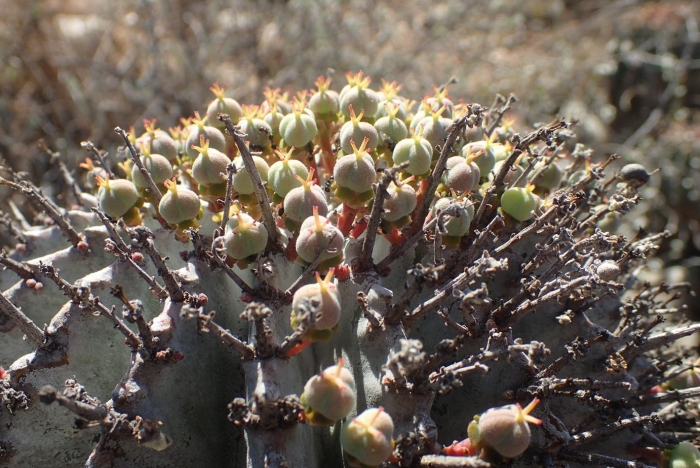African Milk Barrel
(Euphorbia polygona)
African Milk Barrel (Euphorbia polygona)
/
/

Nicola van Berkel
CC BY-SA 4.0
Image By:
Nicola van Berkel
Recorded By:
Copyright:
CC BY-SA 4.0
Copyright Notice:
Photo by: Nicola van Berkel | License Type: CC BY-SA 4.0 | License URL: http://creativecommons.org/licenses/by-sa/4.0/ | Rights Holder: Nicola van Berkel | Publisher: iNaturalist | Date Created: 42671 |
























Estimated Native Range
Summary
Euphorbia polygona, commonly known as African Milk Barrel, is an evergreen succulent plant native to the semi-arid and rocky habitats of South Africa. It typically grows to a height and width of 0.5-2 feet (0.2-0.6 meters), forming a cactus-like appearance with ridged, spiny stems that resemble a barrel. The plant’s coloration can vary from green to blue-green, with older specimens developing a woody base. During the spring, it produces small, inconspicuous green and red flowers that are not particularly showy, but add interest to the plant’s overall appearance.
African Milk Barrel is valued for its drought tolerance and unique architectural form, making it a popular choice for rock gardens, xeriscaping, and as a container plant. It is well-suited to arid and semi-arid climates and requires minimal maintenance once established. Gardeners appreciate its ease of care, requiring full sun exposure and well-draining soil. Overwatering should be avoided to prevent root rot. While it is generally pest-free, it can occasionally be affected by mealybugs or spider mites. It is important to handle this plant with care, as the sap is toxic and can cause skin irritation.CC BY-SA 4.0
African Milk Barrel is valued for its drought tolerance and unique architectural form, making it a popular choice for rock gardens, xeriscaping, and as a container plant. It is well-suited to arid and semi-arid climates and requires minimal maintenance once established. Gardeners appreciate its ease of care, requiring full sun exposure and well-draining soil. Overwatering should be avoided to prevent root rot. While it is generally pest-free, it can occasionally be affected by mealybugs or spider mites. It is important to handle this plant with care, as the sap is toxic and can cause skin irritation.CC BY-SA 4.0
Plant Description
- Plant Type: Succulent
- Height: 0.5-2 feet
- Width: 0.5-2 feet
- Growth Rate: Slow
- Flower Color: Green, Red
- Flowering Season: Spring
- Leaf Retention: Evergreen
Growth Requirements
- Sun: Full Sun
- Water: Very Low, Low
- Drainage: Medium, Fast
Common Uses
Bee Garden, Bird Garden, Butterfly Garden, Deer Resistant, Drought Tolerant, Fire Resistant, Low Maintenance, Rabbit Resistant
Natural Habitat
Semi-arid and rocky habitats in South Africa
Other Names
Common Names:
Scientific Names: , Euphorbia polygona,
GBIF Accepted Name: Euphorbia polygona Haw.